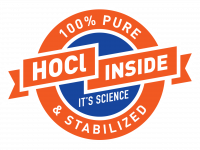Applications for HOCl
Story At-A-Glance
- HOCl performs two primary functions: it kills microbes, and it addresses biofilms.
- HOCl is a chemical component found in something known as “electrolyzed water.”
- Electrolyzed water is classified by its pH characteristic as either strong acid electrolyzed water, weak acid electrolyzed water, slightly acid electrolyzed water, neutralized electrolyzed water, slightly basic electrolyzed water, and strong basic electrolyzed water.
Overview
Research indicates hypochlorous acid (HOCl) performs two primary functions: it kills microbes, and it addresses biofilms.1 According to one definition, a microbe is “a microorganism, especially a pathogenic one such as a bacterium, protozoan, or fungus”.2 A biofilm is “a thin layer of microorganisms adhering to the surface of a structure, which may be organic or inorganic, together with the polymers that they secrete”.3 Biofilms are typically found “on the surface of stones in rivers and ponds, in water pipelines, as dental plaque on teeth, and on surgical implants”.4 As you read through the preceding definitions, the head begins to spin with all the potential applications for HOCl.
Applications for HOCl
When considering applications for HOCl, one simply asks where microbes and biofilms can be found, and where killing them might benefit society. Let’s consider the hospital sector as an example. Healthcare infections can occur wherever microbes are left unchecked to grow at the hospital facility. Assuming these microbes are somehow transmitted to a patient or worker, an infection can result. Left unchecked, this infection can lead to significant illness or death. Microbe growth in these settings may occur on medical equipment, wet or damp surfaces or materials, bathroom settings, ice machines, and surgical site equipment to list just a few.5 According to the Center for Disease Control and Prevention (CDC), healthcare-associated infections are quite common.6 Therefore, one particularly significant application for HOCl research is the hospital sector.
Besides hospitals, other applications for HOCl include animal care and livestock, food industry, produce and crops, water treatment, skin care, eye care, plastic surgery, wound care, dental care, and feminine hygiene.7 As more is known about HOCl, the other applications for which it can be used are virtually limitless.
Research
HOCl is a chemical component found in something known as electrolyzed water (EW). Electrolyzed water is classified by its pH characteristic as either strong acid electrolyzed water, weak acid electrolyzed water, slightly acid electrolyzed water, neutralized electrolyzed water, slightly basic electrolyzed water, and strong basic electrolyzed water.8 Research on EW focuses on these acidic and basic pH variations. Much is yet to be learned about the efficacy of EW as an anti-microbial and anti-biofilm agent, and research continues.
Future articles will feature each of these applications, with a particular focus on the efficacy of HOCl in killing microbes and biofilms.
Sources and References
- 1, 5, 6, 7, 8 New Clinical Applications of Electrolyzed Water: A Review, Pianpian Yan, Eric Banan-Mwine Daliri, and Deog-Hwan Oh, Microorganisms. 2021 Jan; 9(1): 136.
- 2, 3 Miller-Keane Encyclopedia and Dictionary of Medicine, Nursing, and Allied Health, Seventh Edition
- 4 Collins Dictionary of Biology, 3rd ed. © W. G. Hale, V. A. Saunders, J. P. Margham 2005
